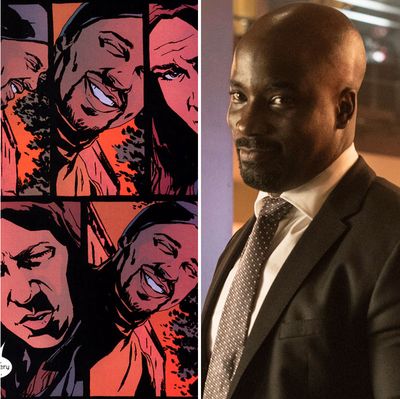
It wasn’t too long ago that Luke Cage, Marvel’s heavily muscled, no-nonsense bruiser of a superhero, existed mainly as a punch line. Existing in the margins of the Marvel universe, many years removed from his own standalone title, the character at the turn of the millennium was a far cry from what he had been at the time of his creation in the early 1970s, when the blaxploitation phenomenon was at its zenith. He was something rare and revolutionary back then, an African-American man who was no one’s sidekick, starring in his own monthly series. Comics writer David F. Walker, who works on Marvel’s current Luke Cage title Power Man & Iron Fist, remembers how exciting it was to be a black adolescent digging into those early, jaw-breaking adventures. “He was this big, black character who was just bringing it,” he recalls. “He was a dude we all knew: the baddest guy on the block.”
But as of early 2001, Luke had disappeared from the spotlight. He was regarded as a jive-talking relic of a long-gone era, a piece of intellectual property who hardly popped up in Marvel’s pages and certainly couldn’t sustain a starring role anywhere. For Walker and other readers of his generation, Luke was a fond but fading memory. Then, Walker received an unexpected recommendation.
“Someone told me, ‘If you like Luke Cage, you’ve gotta check out this book, Alias, because there’s this guy Brian Michael Bendis, who’s doing some crazy stuff with him.” Walker followed his friend’s advice and picked up an issue. There was Luke, still big and black, but somehow transformed. He wasn’t the star of the series, but he was the most prominent member of the supporting cast. He felt like Luke Cage, but a fresh and charismatic Luke Cage for a new century.
When viewers fire up Netflix’s original series Marvel’s Luke Cage today, they won’t see Luke as he was for the first three decades of his existence. They’ll see the one Walker discovered in the early aughts. The show owes its existence to an idiosyncratic, once-in-a-lifetime constellation of creative factors: a publishing house in the midst of a chaotic and foul-mouthed new era; a doughy Jewish guy named Bendis who had an unusual idea; and, bizarrely enough, the comedy of Damon Wayans. Soon, Luke became a star again, and his rocky and abrupt overhaul became one of the most successful reinventions in superhero fiction’s 78-year history.
Only a handful of things were true of both Luke’s creation and revival: his powers, his race, and the fact that white guys were calling the shots. In early 1972, the film phenomenon that would come to be known as blaxpoitation (NAACP leader Junius Griffin coined the term that August, intending it as an insult) was a rising sensation at the box office. Sweet Sweetback’s Baadasssss Song and Shaft had become unlikely hits the previous year, showcasing slick, black action heroes and explosive urban violence. Audiences, black and white, were rapt.
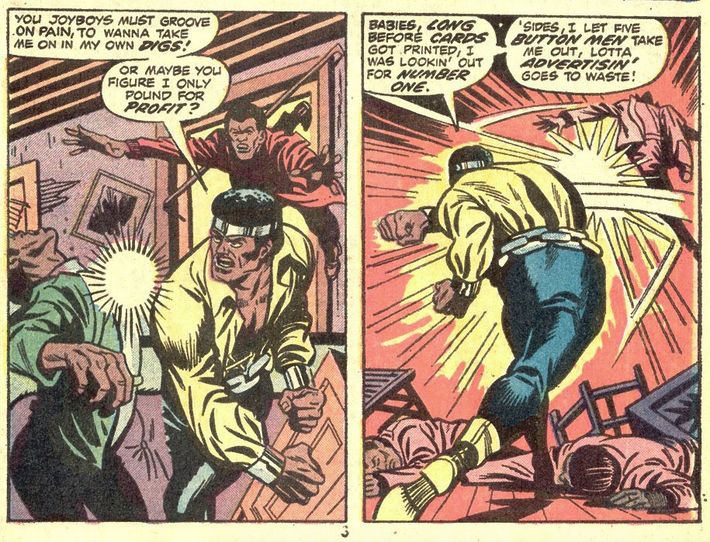
Never one to skip a chance to cash in on a trend, Marvel grand pooh-bah Stan Lee’s mouth watered. He consulted with his protégé, star writer, and newly minted editor-in-chief, Roy Thomas, and the pair quickly brainstormed key traits for a blaxpoitation-inspired character. Lee wanted a punchy and unusual name; Thomas suggested “Cage.” Lee wanted the character to “make a paying career of crime-busting,” Thomas later recalled in an interview for American Comic Book Chronicles; the latter had just written an Avengers story called “Heroes for Hire” and repurposed the phrase as the series’ subtitle. They wanted their creation to be powerful, but not Hulk-level powerful; Thomas drew inspiration from the protagonist of Philip Wylie’s 1930 sci-fi novel Gladiator and made him strong and bulletproof but still vulnerable to heavy weapons.
They tasked artist John Romita Sr. with designing Luke, George Tuska with drawing the initial stories, and Archie Goodwin with writing them. Inker Billy Graham, one of the few black people in the comics industry, was brought in to, as Thomas put it, “make certain that George’s African-American characters looked African-American.” The first issue of Luke Cage: Hero for Hire hit stands in April. It was the first mainstream superhero comic to star a black protagonist, making it a progressive landmark by its very existence.
That first story, “Out of Hell — a Hero!”, introduced readers to a tough loner named Lucas, convicted of a crime he didn’t commit and trapped in a brutal Georgia prison. With the hope of getting parole, he volunteers for a risky experiment that goes awry when a racist guard meddles. Lucas gains strength and bulletproof skin, uses his newfound powers to escape, makes his way to New York City, and adopts a new name based on his old one and his ex-con status: Luke Cage. Hard up for cash, he starts fighting bad guys for paying clients, distributing business cards to onlookers after his battles. He adopts a ridiculous costume comprised of blue stretch pants, a belt made out of a heavy chain, a billowing yellow shirt with a deep V-neck to show his hairless chest, and a silver tiara atop a magnificent Afro. “Outfit’s kinda hokey,” Luke monologues on the penultimate page. “But so what? All part of the super-hero scene.”
His exploits were action-packed and well-structured, though they’re more than a little awkward to read in 2016. The book’s dialogue has aged especially poorly, filled as it was with a lazily stereotypical rendition of African-American vernacular. Luke has silly catchphrases like “Sweet Christmas!” and “Sweet sister!” “Busted up most o’ the place,” he says in the sixth issue, written by Steve Englehart and Gerry Conway. “D.W.’s uncle gonna be honked off enough as is — so you jokers might’s well take the chair, too!” He smashes a chair on a baddie’s ass, and after another threatens that they’ll return, Luke shouts, “Anytime, jivemouth — it don’t make any difference! Luke Cage is number one!” He turns around to see two alluring white women. “Mornin’, ladies,” he intones. “Can I help you?”
The book remained groundbreaking for its focus on an African-American experience and gained a cult following, despite its more ignorant elements leaving some black consumers cold. As comics writer and critic Christopher Priest would later write:
“[A]s a reader, most of that work seemed disingenuous, having not much in the way of anything that was true to my experience as a black youth in America. … A great deal of it is an appropriation of black culture and voice; it seems to be what white people think black people are.”
Nevertheless, Marvel’s leadership fell in love with Luke, putting him at the top of a 1972 internal ranking of properties with the most marketing potential. When sales of his solo series declined in the latter half of the decade, they doubled down, pairing him with martial-arts hero Iron Fist. Their duo title, the original incarnation of Power Man & Iron Fist, was never a top seller for Marvel, but it garnered acclaim from critics, especially during the long writing runs of Jo Duffy and, later, Priest, then working under the moniker Jim Owsley. But in 1986, with blaxploitation long out of favor and the series’ sales on the decline, Marvel canceled it. A few Luke stories continued to trickle out in the form of cameos and short stories within anthology comics, but that, too, slowed. There was a brief attempt to revive him with a solo series called Cage in 1992, but it was nixed after 20 issues. He was put in a team book called Heroes for Hire in 1996; it only lasted for 19.
By the end of the century, Luke had become a joke. When Priest took over writing duties on Deadpool in 1999, he put Luke in a meta-fictional scene that revealed him to be trapped in an otherworldly limbo for unpopular and discarded Marvel characters. “Sho’ nuff,” he mumbles to no one in particular, his words written in tiny type. “Sweet Rosh Hashanah. What it is.”
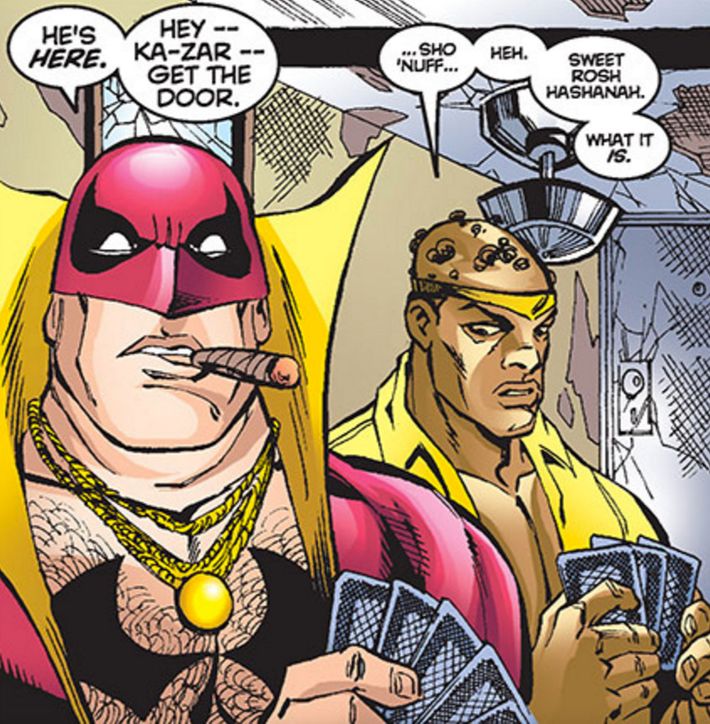
There wasn’t much of a reason to believe he’d ever escape that limbo. Then salvation came from an unlikely source.
Given his diminutive stature and upbringing as a bookish Cleveland Jew, you’d be hard-pressed to find a comics professional less like Luke Cage than Brian Michael Bendis. But there’s something oddly appropriate about the fact that their destinies intertwined: Bendis, like the character he made famous, was a struggling C-lister who was quickly shoved into the spotlight. He was 32 in 1999, writing indie noir comics that earned good reviews but microscopic market penetration — he’d declare it a victory if he sold 2,000 copies and earned $400. He was making more money as a caricature artist at bar mitzvahs on the weekends.
At the time, though, he wasn’t alone in his suffering. Comic books briefly became hot collector’s items in the early 1990s, placing the industry atop a speculation bubble that burst in the middle of the decade. Sales plummeted and chaos ensued. Marvel was hit particularly hard. Its stock became worthless, the company declared bankruptcy in 1996, prospective buyers locked horns, and editors were repeatedly shuffled around in a dizzying game of musical chairs.
It was against that backdrop that the financially ailing Bendis got a fateful call from the financially ailing Marvel in early 1999. The publisher’s leadership was flailing in an attempt to find new creative strategies, and an indie-comics writer-artist named Joe Quesada had been tasked with headhunting new voices from outside the superhero scene. He was a fan of Bendis and recruited him to write a new take on Spider-Man for a new Marvel imprint called Ultimate Marvel. Bendis took the job but was shocked at how unstable his new employer was. “My first visit to the Marvel bullpen was haunting, because they were literally selling filing cabinets,” Bendis told me in 2014.
To everyone’s surprise, Ultimate Spider-Man became a hit in 2000 and the Ultimate line that Bendis kicked off almost single-handedly righted the Marvel ship. Dependable and personable, the higher-ups fell in love with him. Not long after he finally felt he was making enough money to quit his caricaturing job, Bendis was asked to do something Marvel had never done before: get dirty.
The company, as part of its ongoing attempt to throw everything at the wall and see what stuck, was planning to launch a line of adults-only comics called Marvel MAX, filled with swearing and sex. “Our CEO, Peter Cuneo, saw that ‘mature’ comics had a significant number of readers and that Marvel wasn’t publishing for the ‘adult’ market,” recalls Bill Jemas, the executive in charge of Marvel’s editorial direction at the time. “He asked Joe Quesada and me to see what we can do. We called Brian Bendis and asked him what he would do if we let him do a uncensored book, with pretty much full creative freedom. He said, ‘Really?’ We said, ‘Yes.’ And pow, he came up with Alias.”
The series launched in September of 2001 with Michael Gaydos on art duties. It focused on an all-new character named Jessica Jones, an alcoholic and miserable ex-superhero working as a private eye and solving street-level cases that the Avengers or the Fantastic Four would never touch. From the very first page, in which every line of dialogue featured an f-bomb, it was instantly unlike anything a Marvel writer had ever produced. Not only was it foul-mouthed and cynical, it also featured a shocking scene in which Jessica has drunken anal sex. Her partner in the act? The hero for hire himself, Luke Cage.
Bendis had loved Luke as a youngster and his decision to pop him into the story came from a simple line of logic. “It started with: If Jessica is down here on the street, who would she be bumping into the most?” he recalls. Luke’s origins as an urban brawler made him a perfect fit. Bendis didn’t just want him for an erotic cameo, either: He planned to make Luke a recurring character, which left his bosses more than a little confused. “He was not high on their priority list,” Bendis says, “so my focus on him was often met with cracks about my ‘man-crush’.”
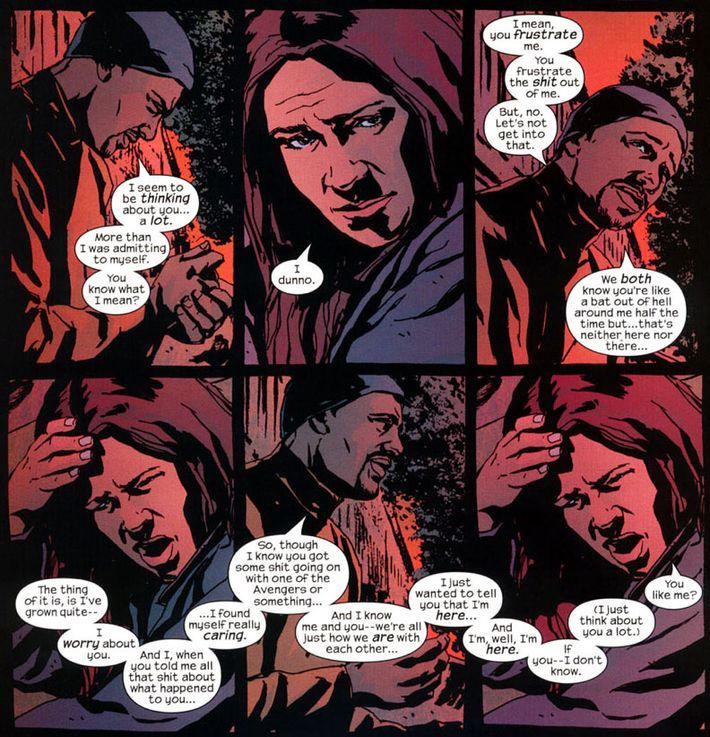
By his own account, Bendis wanted to “scrape off the dated ‘funky honky’ blaxploitation part and focus on the man, a man of the 21st century.” Part of that meant a chilled-out approach to his voice, including the removal of eye roll–worthy slang and the stilted barks of a typical superhero (as he’d had in the 1992 solo series). He and Gaydos brainstormed a new visual approach, too. That meant no more bright, superheroic outfits and no more metallic accessorizing. The look they landed on was, appropriately enough, quite similar to that of Samuel L. Jackson in the previous year’s Shaft remake: pencil-thin facial hair (initially a mustache, later a goatee), modest streetwear with mostly muted tones, slyly charming speech patterns, and a crafty smile.
Alias found Luke out of the superhero game, running a bar and doing low-key bodyguard work. Between Bendis’s conversational, mature dialogue and Gaydos’s rendition of his confident smiles and judgmental grimaces, you couldn’t take your eyes off of him whenever he popped up. After a few awkward post-coital encounters, Luke helps the spiraling Jessica get a gig bodyguarding alongside him for Daredevil’s alter ego, Matt Murdock. When things get tense between the two of them, Luke delivers a direct but empathetic message to her.
“I still got Murdock to help you out of the clusterfuck you made of your life,” he says, his brow crinkling ever so slightly and his voice never rising to a shout. “And you know what you did after that? Well, I don’t know what you did then — but it sure as fuck wasn’t thanking me for being there for you when you needed me. Two adults.” He points at her. “Adult.” He points at himself. “Adult.” He holds up two meaty fingers. “Both adults.” Jessica warms to him. They exchange banter (Luke gets very close to making a joke about Iron Fist being into fisting, but Jessica stops him before he can get to the punch line). He asks her on a date. She declines, but any reader can tell where this whole thing will eventually go. Bendis and Gaydos imbued the pair with palpable chemistry predicated on a completely new conception of Luke as an aging and understated gentleman.
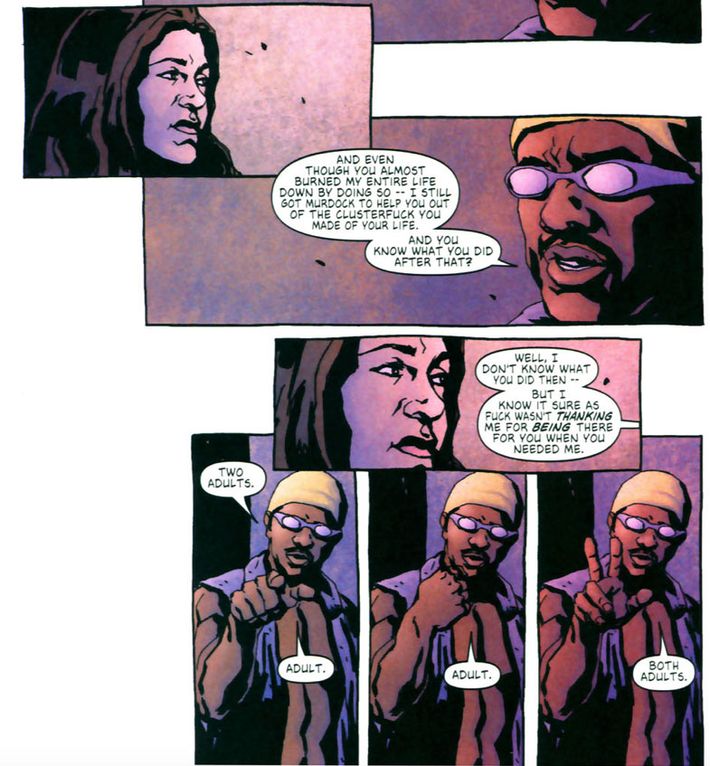
Alias was a critical smash. Quesada, newly promoted to editor-in-chief, loved this unexpected reemergence of Luke Cage. However, his next move for the character would prove to be much more controversial. In 2002, Luke was given his own MAX mini-series, simply titled Cage, that was self-contained and set outside of normal continuity, allowing for a story wholly untethered to what had happened in Alias. A new editor named Axel Alonso — who would go on to succeed Quesada as EIC and hold the role to this day — was put in charge of it. “Our goal was to do an updated, hip-hop-flavored blaxploitation flick,” Alonso says, “with all the trappings of the genre, in comic book form.”
The comic’s writer, Brian Azzarello, had been itching to do a Luke Cage story for a while, and he pushed the character’s limits much farther than Alias. Whereas Bendis had focused on the smooth-talking charm of ‘70s Luke, Azzarello was more interested in that original version’s status as a hired gun. “I liked some of the more questionable, gray moral aspects of the character,” Azzarello recalls. He took inspiration from the tracks of rappers like Nas, the Notorious B.I.G., and the Geto Boys. “With the whole Luke Cage, ‘I gotta get paid’ mythos, gangsta rap just seemed like a natural fit.”
Cage was pure pulp. In series artist Richard Corben’s rendition, this version of Luke was a hulking bruiser who sauntered through the streets of New York behind reflective shades, wearing gold chains, a flashy watch, headphones, and a do-rag. His narrative was loosely based on that of Akira Kurosawa’s Yojimbo, with Luke playing gangbangers, corrupt cops, and avaricious politicians off of one another while scaring the shit out of everyone in the process. Azzarello and Corben had Luke break bones and hang around in the nude with a well-endowed female companion (they wanted to show off Luke’s penis and got vetoed, though the original art surfaced a few years ago).
“Cage was disrespectful and insulting to the character,” says comics critic Joseph P. Illidge, who frequently writes about race in the industry. In his mind, the series turned Luke into a “Black Buck,” a longstanding racist stereotype of a violent, sexually insatiable black man. In a contemporary review, critic Hannibal Tabu said the series “has all the trappings of college frat boys who have just discovered Shaft and begin to mockingly emulate everything ‘black’ as something ‘cool’ before they graduate and go on to white lives.” Alonso and Azzarello say they’re still proud of the series, and the latter laments the fact that Marvel doesn’t do stuff like his take on Luke anymore. “It would never happen today,” he says. “Everything’s on a lunchbox, man.”
Meanwhile, Luke had become Bendis’s muse. In nearly every place the writer found himself, he brought his refurbished fictional companion with him. In Daredevil, Luke fought and quipped alongside the title character. In The Pulse, the cleaned-up sequel to Alias, Luke and Jessica moved in together after Jessica got pregnant with their child. In Secret War, Luke got recruited for a top-secret plot to take out Doctor Doom. When Bendis was given the keys to Marvel’s flagship team, the Avengers, in the middle of the decade, he put Luke in the lineup — a place he’d never been in his more than three decades of existence. With every story, Bendis refined the character’s voice, balancing his wit and charisma with determination and a decidedly non-mercenary moral center.
Bendis also kept tinkering with the character’s appearance — including, after putting Luke on the Avengers, removing his hair. That may seem like an inconsequential decision, but superhero stories are overwhelmingly visual, and Luke’s baldness has become one of his defining traits. Bendis’s inspiration for that choice came from a decidedly unmenacing public figure. Luke “was being drawn by some artists with almost a half-fro, like he was balding,” he says. “I saw Damon Wayans talking about why he shaved his head, because of his half-fro, and how everyone instantly thought of him as cooler and more potent of a comedian.” If it worked for Wayans, why not for Cage? At the hands of penciler David Finch, the bald pate made its debut in 2005’s New Avengers No. 2 and it hasn’t gone away since.
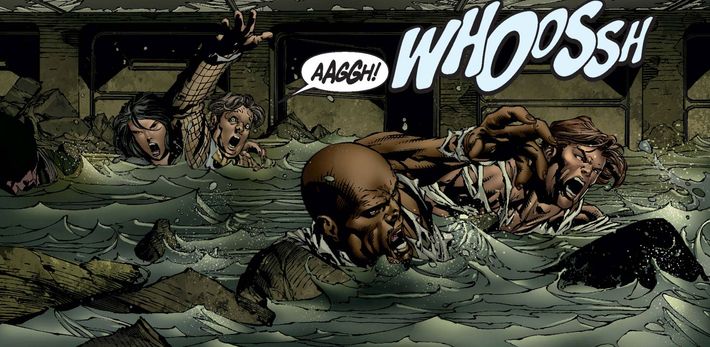
Nor did the hero underneath the chrome dome. By the 10th anniversary of Priest’s 1999 diss in Deadpool, it had become hard to imagine a Marvel Comics universe without Luke Cage in a lead role of one sort or another. He’s starred in series after series, most recently in the revived Power Man & Iron Fist that’s written by Walker and drawn by Sanford Greene. Both creators are black men, making this the first time in more than 20 years that Marvel’s first African-American lead character has been guided by an all-black creative team — something long overdue, but much needed in a period when Marvel has faced criticism for its lack of diversity in top creative roles.
And then there’s what is arguably the most important development for Luke Cage, which is, of course, his introduction to the ongoing filmed-superhero boom. When Marvel signed a partnership with Netflix in 2013, it announced that their original-series lineup would consist of four series, each starring a Marvel character known for gritty, street-level stories. Luke was one of them. Played by The Good Wife alum Mike Colter, the character debuted in 2015 on — appropriately enough — Marvel’s Jessica Jones. Following his solo series, he’s going to next be one of the leads in next year’s team-up show The Defenders. Nearly 45 years after his creation, this revolutionary character is about to have his biggest audience yet.
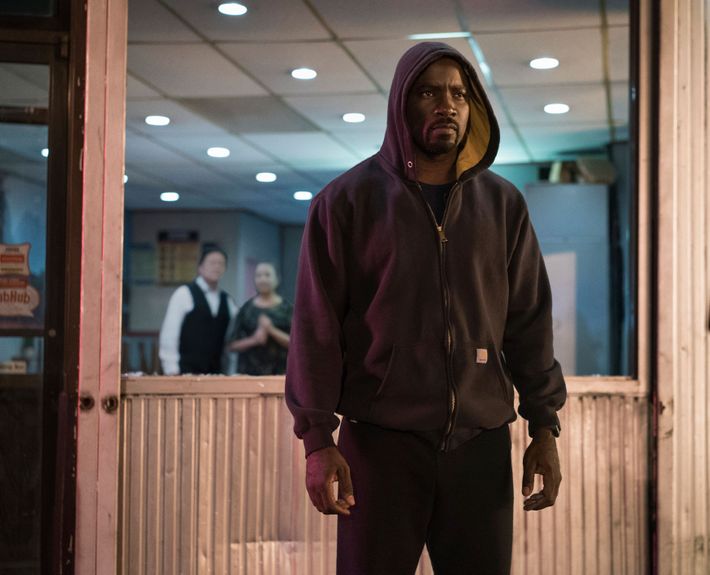
And yet, the Luke Cage that appears in Luke Cage is definitively not the Luke Cage of 1972. That guy would be barely recognizable to the untold number of people who will stream their first exposure to him this weekend. “I grew up reading [Luke Cage comics], but there were very few times that character had the opportunity to be philosophical, or live in the real world,” showrunner Cheo Hodari Coker has said. “That was the one thing I really liked about Brian’s update of the character.”
Walker got to see some episodes of Luke Cage in advance and was immediately struck by how pleasantly different he was from the character he’d first read back in the day. “The stories from the ‘70s were great stories, but there was a bit of silliness to it and they existed in a world that so did not resemble the world that any black person I’d ever met in my life had lived in,” he says. “Now, I see a character far more complex and mature and engaging.” Colter is playing the man Bendis cooked up while he was still a newbie to superhero comics: quiet and goateed, clever and charismatic, his demeanor as smooth as the top of his head. A decade and a half ago, Luke was a man out of time. Now, as he strides the streets of Harlem with a hoodie and a quiet sense of determination, he feels eminently of the moment.

